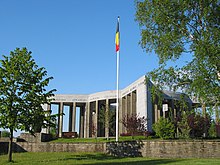Bastogne
Bastogne (French pronunciation: [bas.tɔɲ] ⓘ; Dutch: Bastenaken [ˈbɑstəˌnaːkə(n)] ⓘ; German: Bastnach/Bastenach [ˈbast(ə)nax]; Luxembourgish: Baaschtnech [ˈbaːʃtnəɕ] ⓘ) is a city and municipality of Wallonia located in the province of Luxembourg in the Ardennes, Belgium.
A form of the name Bastogne was first mentioned only much later, in 634, when the local lord ceded these territories to the St Maximin's Abbey, near Trier.
By the 13th century, Henry VII, Holy Roman Emperor and count of Luxemburg, was minting coins in Bastogne.
In 1332, John the Blind, his son, granted the city its charter and had it encircled by defensive walls, part of which, the current Porte de Trèves, still exists.
In 1688, they were dismantled by order of King Louis XIV when the town was occupied by French forces during the Nine Years War.
Hitler's plan was to regain control of the Ardennes, splitting British from American forces, then advance to and reoccupy the strategic port of Antwerp and cut off the key Allied supply line.
The Battle of the Bulge began on 16 December, when German artillery, taking advantage of cold and fog, attacked the American divisions deployed sparsely around Bastogne.
Bastogne has an oceanic climate similar to the remainder of Belgium, but with more continental influences due to it being inland and elevated in comparison to lowland areas nearer the Atlantic.

